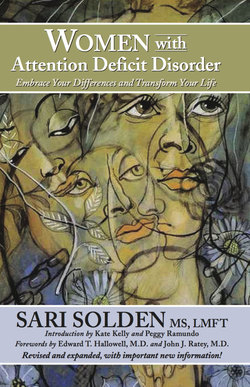Читать книгу Women With Attention Deficit Disorder: Embrace Your Differences and Transform Your Life - Sari Boone's Solden - Страница 4
На сайте Литреса книга снята с продажи.
ORIGINAL FOREWORD by John J. Ratey, M.D. (1993)
ОглавлениеCurrent developments in cognitive science are enabling researchers to uncover the many secrets of the brain. Techniques such as neuro-imaging allow us to observe, measure, and analyze brain activity as it occurs, leading us closer and closer to an understanding of the brain’s tremendous complexity. For many individuals, however, the excitement of this progress is accompanied by the threat that ultimately everything will be defined in terms of matter, and the more ethereal category of the human spirit will no longer by acceptable.
Most recently, neurological discoveries have been complemented by advances in genetics. Yet this advancement is met with resistance as well as by those who oppose the idea that we may be controlled by the past or defined in any way by our genetic destiny. To many, this idea seems to invalidate the core of our very existence, namely, the quest to achieve our own individuality. If even our most subtle characteristics were determined by our genetic history, this achievement would be impossible. What we are beginning to learn, however, is that genetic guidance is exceedingly sensitive to the environment. In fact, neuroscientists, along with others who are delving into the mysteries of human consciousness, emphasize that individuality is apparent throughout the brain. This variation is, for the most part, due to each individual’s unique experience of the world. We are learning that everything counts, that everything we experience impacts brain development. While the brain remains susceptible to environmental influences throughout life, the greatest impact occurs in utero, during the first stages of existence.
Of particular interest is the role of hormones in the development of the brain, especially in regard to gender differences.
It is now a commonly accepted fact that men and women’s brains differ as a result of exposure to different hormonal environments in the womb. This difference does not imply that one environment is preferable to the other, but simply that they each produce unique effects. After birth, the brain continues to develop and is constantly reorganized through the experience of the environment, especially that of the interpersonal and social milieu. Thus, along with the furious pace at which we are gaining knowledge about the brain and genetics, we are also reconfirming scientifically the belief that the social environment contributes a great deal to the development of the brain and the mind.
For example, these social influences may cause a genetic condition such as Attention Deficit Disorder to be expressed quite differently even among members of the same family. By examining this interplay between genetics and environment, Sari Solden has broken new ground in Women With Attention Deficit Disorder: Embracing Disorganization at Home and in the Workplace, a book that follows that dictate of Dr. William Osler, who stated: “Ask not what disease the person has, but rather what person has the disease.” On both a personal and professional level, Solden explores just how women deal with the neurologic difference that is ADD. She at once narrows our perspective and broadens our understanding by revealing how the genetic composition of this disorder is manifested in women. Until recently, most disorders had been considered only from a limited perspective, one that explained how the condition was expressed in men. When data was presented regarding both sexes, gender differences at the level of genetics and development were rarely, if ever, reported. In examining the gender differences of ADD, not only hormonal but also social influences are important as well, especially as this disorder is often subtle and hidden from view.
For a woman, the ADD traits of impulsivity, carelessness, forgetfulness, changeability and procrastination extend far beyond the environment of work or school to include every aspect of her life. They exist at the very core of a woman’s expectations of herself and of society’s expectations of her as well. The expectation that she will be the rock, the dependable, steady force in every situation causes her to be much more susceptible to the confining and crippling emotion of shame. This dynamic acts subtly, yet is extremely persuasive and often inhibits the growth from every direction of a woman who has ADD. In Women with Attention Deficit Disorder, Sari presents us with a number of meaningful anecdotes and a wealth of invaluable clinical lore. Her work represents one of the first attempts to broaden our perspective by focusing the experience of the genetic disorder on that of women alone. She provides us with a crucial understanding of a woman’s experience of ADD within a complicated social matrix.
Dr. John J. Ratey, M.D., is an Associate Clinical Professor of Psychiatry at Harvard Medical School and has a private practice in Cambridge, Massachusetts. Dr. Ratey has authored the best selling book, A User’s Guide to the Brain. He has also co-authored Driven to Distraction (1994) and Answers to Distraction (1995) and Delivered from Distraction (2005) with Edward Hallowell, M.D., and Shadow Syndromes (1997) with Catherine Johnson, Ph.D.
